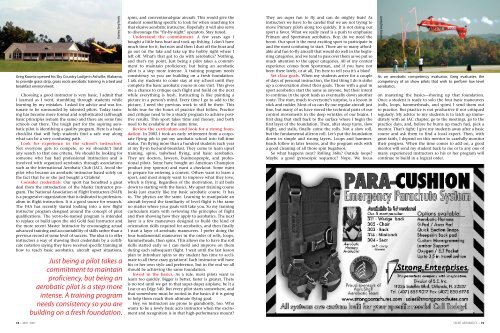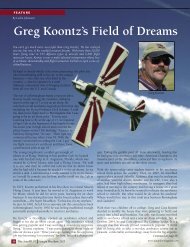Bed & Breakfast . . . Bed & Breakfast . . . - Greg Koontz Aviation!
Bed & Breakfast . . . Bed & Breakfast . . . - Greg Koontz Aviation!
Bed & Breakfast . . . Bed & Breakfast . . . - Greg Koontz Aviation!
You also want an ePaper? Increase the reach of your titles
YUMPU automatically turns print PDFs into web optimized ePapers that Google loves.
<strong>Greg</strong> <strong>Koontz</strong> opened his Sky Country Lodge in Ashville, Alabama,<br />
to provide grass strip, grass roots aerobatic training in a bed and<br />
breakfast environment.<br />
Choosing a good instructor is very basic. I admit that<br />
I learned as I went, stumbling through students while<br />
learning by my mistakes. I asked for advice and was fortunate<br />
to be surrounded by talented pilots. Today training<br />
has become more formal and sophisticated (although<br />
basic principles remain the same) and there are some fine<br />
schools out there. The tough part for the aspiring aerobatic<br />
pilot is identifying a quality program. Here is a basic<br />
checklist that will help students find a safe way along<br />
what can be a very confusing path.<br />
Look for experience in the school’s instructors.<br />
Not everyone gets to compete, so we shouldn’t limit<br />
any search to that one criteria. We should be looking for<br />
someone who has had professional instruction and is<br />
involved with organized aerobatics through associations<br />
such as the International Aerobatic Club (IAC). Avoid the<br />
pilot who became an aerobatic instructor based solely on<br />
the fact that he or she just bought a Citabria!<br />
Consider credentials. Our sport has benefited a great<br />
deal from the introduction of the Master Instructor program.<br />
The National Association of Flight Instructors (NAFI)<br />
is a progressive organization that is dedicated to professionalism<br />
in flight instruction. It is a good source for research.<br />
The FAA has recently started looking into a new flight<br />
instructor program designed around the concept of pilot<br />
qualifications. The yet-to-be-named program is intended<br />
to replace or build upon the old Gold Seal Instructor and<br />
the more recent Master Instructor by encouraging actual<br />
advanced training and accountability of skills rather than a<br />
previous record of some level of success. The idea is to offer<br />
instructors a way of showing their credentials by a certificate<br />
notation saying they have received specific training in<br />
how to teach basic aerobatics, aircraft upset situations,<br />
Courtesy <strong>Greg</strong> <strong>Koontz</strong><br />
Just being a pilot takes a<br />
commitment to maintain<br />
proficiency, but being an<br />
aerobatic pilot is a step more<br />
intense. A training program<br />
needs consistency so you are<br />
building on a fresh foundation.<br />
spins, and conventional-gear aircraft. This would give the<br />
student something specific to look for when searching for<br />
that elusive aerobatic instructor. Hopefully it will also serve<br />
to discourage the “fly-by-night” operators. Stay tuned.<br />
Understand the commitment. A few years ago I<br />
bought a little bass boat and took up fishing. I don’t have<br />
much time for it, but now and then I dust off the boat and<br />
go out on the lake and take up the hobby right where I<br />
left off. What’s that got to do with aerobatics? Nothing,<br />
and that’s my point. Just being a pilot takes a commitment<br />
to maintain proficiency, but being an aerobatic<br />
pilot is a step more intense. A training program needs<br />
consistency so you are building on a fresh foundation.<br />
I ask my students to come stay at my school until they<br />
complete the basic aerobatic course in one visit. This gives<br />
me a chance to critique each flight and build on the next<br />
while everything is fresh. Instructing is like painting a<br />
picture in a person’s mind. Every time I go to add to the<br />
picture, I need the previous work to still be there. This<br />
holds true for the hours of practice that follow. Practice<br />
and critique need to be a steady program to achieve positive<br />
results. This sport takes time and money, and both<br />
need to be available at the same time.<br />
Review the curriculum and look for a strong foundation.<br />
In 2002 I took an early retirement from a corporate<br />
flying job to put my aerobatic school into full-time<br />
status. I’m flying more than a hundred students each year<br />
at my fly-in bed-and-breakfast. They come to learn upset<br />
training, spins, tailwheel flying, and basic aerobatics.<br />
They are doctors, lawyers, businesspeople, and professional<br />
pilots. Some have bought an American Champion<br />
product (my sponsor) and want a checkout. Some want<br />
to prepare for entering a contest. Others want to learn a<br />
sport, and most simply want to improve what they love,<br />
which is flying. Regardless of the motivation, it all boils<br />
down to starting with the basics. My upset training course<br />
looks just exactly like my basic aerobatic course. It has<br />
to. The physics are the same. Learning to manipulate an<br />
aircraft beyond the familiarity of level flight is the same<br />
no matter where your goals will take you. So my training<br />
curriculum starts with reviewing the principles of flight<br />
and then showing how they apply to aerobatics. The next<br />
layer is a few maneuvers designed to build the kind of<br />
orientation skills required for aerobatics, and then finally<br />
I start a layer of aerobatic maneuvers. I prefer doing the<br />
four fundamental maneuvers in the order of rolls, loops,<br />
hammerheads, then spins. This allows me to have the roll<br />
skills started early so I can mold and improve on them<br />
during each subsequent flight. I wait until the last lesson<br />
plan to introduce spins so my student has time to acclimate<br />
to all these crazy gyrations! Each instructor will have<br />
his or her own style and preference, but in the end we all<br />
should be achieving the same foundation.<br />
Invest in the basics. As a rule, most pilots want to<br />
learn too quickly. Bigger is better, faster is greater. There<br />
is no rest until we get to that super-duper airplane, be it a<br />
Lear or an Edge 540. But every pilot starts somewhere, and<br />
that somewhere must be rooted in the basics if it is going<br />
to help them reach their ultimate flying goal.<br />
Hey, we instructors are prone to grandiosity, too. Who<br />
wants to be a lowly basic acro instructor when the excitement<br />
and recognition is in that high-performance mount?<br />
They are super fun to fly and can do mighty feats! As<br />
instructors we have to be careful that we are not trying to<br />
move Primary pilots along too quickly. It is not doing our<br />
sport a favor. What we really need is a push to emphasize<br />
Primary and Sportsman aerobatics. Boy, do we need the<br />
boost. Our sport is the most exciting sport to participate in<br />
and the most confusing to start. There are so many affordable<br />
and fun-to-fly aircraft that would do well in the beginning<br />
categories, and we tend to pass over them as we put so<br />
much attention to the upper categories. All of my contest<br />
experience comes from Sportsman, and if you have not<br />
been there lately, or at all, I’m here to tell you it’s a blast!<br />
Set clear goals. When my students arrive for a couple<br />
of days of personal instruction, the first thing I do is strike<br />
up a conversation about their goals. Those with a goal in<br />
sport aerobatics start the same as anyone, but their intent<br />
to continue in the sport leads us eventually down another<br />
route. The start, much to everyone’s surprise, is a lesson in<br />
stick and rudder. Most of us can fly our regular aircraft just<br />
fine, but many of us have stored the technical parts of our<br />
control movements in the deep wrinkles of our brains. I<br />
first drag that stuff back to the surface where I begin the<br />
first layer of the foundation. Then, after steep turns, slow<br />
flight, and stalls, finally come the rolls. Not a slow roll,<br />
but the fundamental aileron roll. Let’s put the foundation<br />
down in simple and strong layers. Loops and hammerheads<br />
follow in later lessons, and the program ends with<br />
a good cleaning of all those spin bugaboos.<br />
So what happens next? Rolling 360s? Outside loops?<br />
Maybe a good gyroscopic sequence? Nope. We focus<br />
As an aerobatic competency evaluator, <strong>Greg</strong> evaluates the<br />
competency of air show pilots that wish to perform low level<br />
aerobatics.<br />
on mastering the basics—shoring up that foundation.<br />
Once a student is ready to solo the four basic maneuvers<br />
(rolls, loops, hammerheads, and spins) I send them out<br />
to practice. But practice is not productive if not critiqued<br />
regularly. My advice to my students is to latch up immediately<br />
with an IAC chapter, go to the meetings, go to the<br />
practice days, and, before he burns up much fuel, pick a<br />
mentor. That’s right; I give my students away after a basic<br />
course and ask them to find a local expert. Then, with<br />
great faith, I depend on this mentor to carefully monitor<br />
their progress. When the time comes to add on, a good<br />
mentor will send my student back to me or to any one of<br />
many experienced instructors so his or her program will<br />
continue to build in a logical order.<br />
18 • MAY 2007 SPORT AEROBATICS • 19<br />
Courtesy <strong>Greg</strong> <strong>Koontz</strong>



